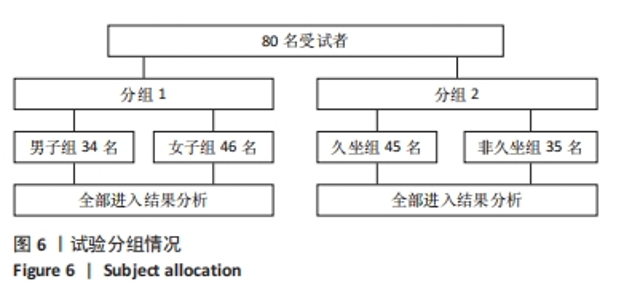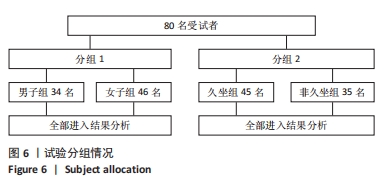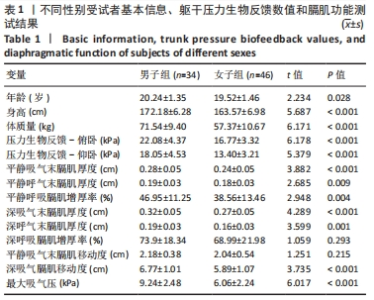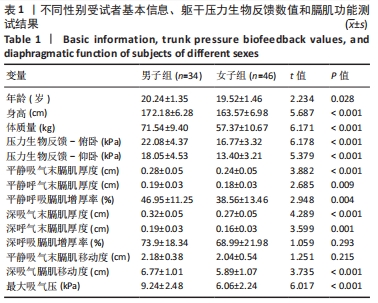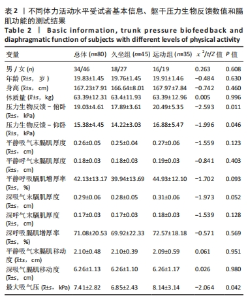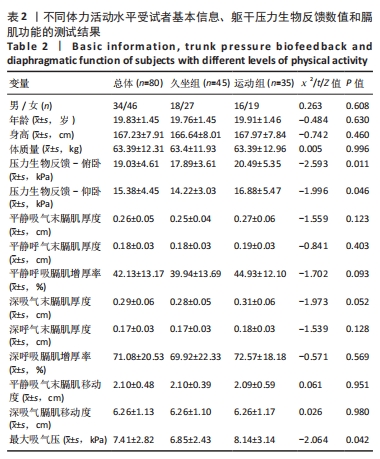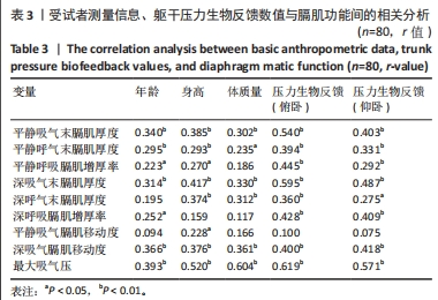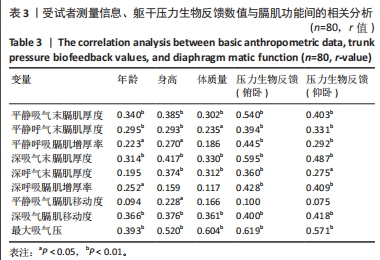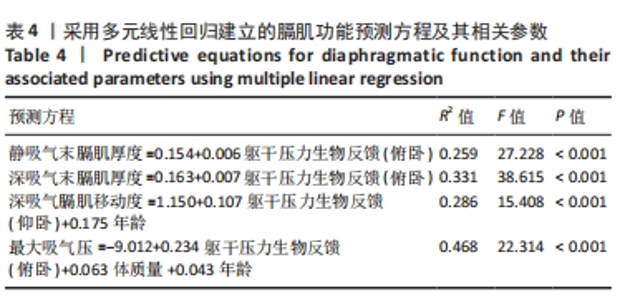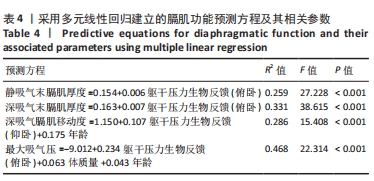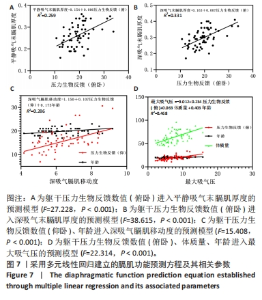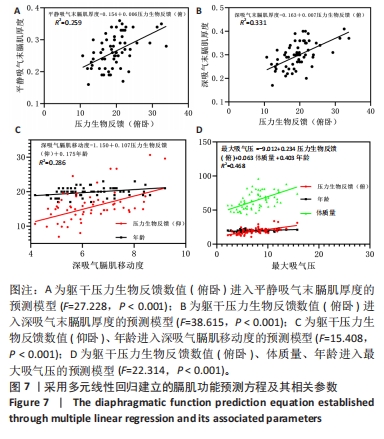[1] 王庭槐.生物反馈及其机理进展 [J].医学信息,2002(10):610-614.
[2] 李旭,郭险峰.慢性腰痛患者躯干旋转肌群肌力与腰部稳定性的关系[J].中国康复理论与实践,2010,16(11):1012-1014.
[3] KAPDULE P, POL T. Relationship between Core Stability and Physical Activity in Young Adults. Int J Health Sci Res. 2019;126:291-300.
[4] 董煜琳,王雪强,胡静芸.压力生物反馈仪测试腰痛的信度评价[J].中国组织工程研究,2015,19(37):6060-6063.
[5] PADKAO T, BOONLA O. Relationships between respiratory muscle strength, chest wall expansion, and functional capacity in healthy nonsmokers. J Exerc Rehabil. 2020;16(2):189-196.
[6] PINET C, CASSART M, SCILLIA P, et al. Function and bulk of respiratory and limb muscles in patients with cystic fibrosis. Am J Respir Crit Care Med. 2003;168(8):989-994.
[7] ERYÜKSEL E, CIMŞIT C, BEKIR M, et al. Diaphragmatic Thickness Fraction in Subjects at High-Risk for COPD Exacerbations. Respir Care. 2017;62(12):1565-1570.
[8] DEPALO VA, PARKER AL, AL-BILBEISI F, et al. Respiratory muscle strength training with nonrespiratory maneuvers. J Appl Physiol. 2004;96(2): 731-734.
[9] HODGES PW, GANDEVIA SC. Changes in intra-abdominal pressure during postural and respiratory activation of the human diaphragm. J Appl Physiol (1985). 2000;89(3):967-976.
[10] GANDEVIA SC, REFSHAUGE KM, COLLINS DF. Proprioception: peripheral inputs and perceptual interactions. Adv Exp Med Biol. 2002;508:61-68.
[11] JANSSENS L, MCCONNELL AK, PIJNENBURG M, et al. Inspiratory muscle training affects proprioceptive use and low back pain. Med Sci Sports Exerc. 2015;47(1):12-19.
[12] LEE K, PARK D, LEE G. Progressive respiratory muscle training for improving trunk stability in chronic stroke survivors: a pilot randomized controlled trial. J Stroke Cerebrovasc Dis. 2019;28(5):1200-1211.
[13] FINTA R, BODA K, NAGY E, et al. Does inspiration efficiency influence the stability limits of the trunk in patients with chronic low back pain? J Rehabil Med. 2020;52(3):jrm00038.
[14] MUSTAFAOGLU R, DEMIR R, DEMIRCI AC, et al. Effects of core stabilization exercises on pulmonary function, respiratory muscle strength, and functional capacity in adolescents with substance use disorder: Randomized controlled trial. Pediatr Pulmonol. 2019;54(7): 1002-1011.
[15] YOON HS, CHA YJ, YOU JSH. The effects of dynamic core-postural chain stabilization on respiratory function, fatigue and activities of daily living in subacute stroke patients: A randomized control trial. NeuroRehabilitation. 2020;47(4):471-477.
[16] STRONGOLI LM, GOMEZ CL, COAST JR. The effect of core exercises on transdiaphragmatic pressure. J Sports Sci Med. 2010;9(2):270-274. eCollection 2010.
[17] HELLYER NJ, ANDREAS NM, BERNSTETTER AS, et al. Comparison of Diaphragm Thickness Measurements Among Postures Via Ultrasound Imaging. PM R. 2017;9(1):21-25.
[18] SARWAL A, WALKER FO, CARTWRIGHT MS. Neuromuscular ultrasound for evaluation of the diaphragm. Muscle Nerve. 2013;47(3):319-329.
[19] 陈颖,易杰.膈肌超声在麻醉管理中的应用进展[J].中国医学科学院学报,2022,44(5):891-898.
[20] BOUSSUGES A, GOLE Y, BLANC P. Diaphragmatic motion studied by m-mode ultrasonography: methods, reproducibility, and normal values. Chest. 2009;135(2):391-400.
[21] ANDERSON BE, BLIVEN KCH. The use of breathing exercises in the treatment of chronic, nonspecific low back pain. J Sport Rehabil. 2017; 26(5):452-458.
[22] WALLDEN M. The diaphragm–more than an inspired design. J Bodyw Mov Ther. 2017;21(2):342-349.
[23] SHAH SG, CHOEZOM T, PRABU RAJA G, et al. Comparison of respiratory parameters in participants with and without chronic low back pain. J Bodyw Mov Ther. 2019;23(4):894-900.
[24] HACKETT DA. Lung function and respiratory muscle adaptations of endurance-and strength-trained males. Sports (Basel). 2020;8(12):160.
[25] YÜKSEL F, GUZEL NA, TASPİNAR B, et al. Relationship between trunk muscle endurance, pulmonary function, and respiratory muscle strength in healthy individuals. Turk J Physiother Rehabil. 2020;31(3): 255-262.
[26] AKTAN ÖO, AKTAN R, YAKUT H, et al. The effects of respiratory muscle functions on trunk muscle endurance in healthy young adults. J Basic Clin Health Sci. 2021;7(2):652-659.
[27] BORDONI B, ZANIER E. Anatomic connections of the diaphragm: influence of respiration on the body system. J Multidiscip Healthc. 2013;6:281-291.
[28] FRANK C, KOBESOVA A, KOLAR P. Dynamic neuromuscular stabilization & sports rehabilitation. Int J Sports Phys Ther. 2013;8(1):62-73.
[29] HODGES PW, GANDEVIA SC. Activation of the human diaphragm during a repetitive postural task. J Physiol. 2000;522 Pt 1(Pt 1):165-175.
[30] AADAHL M, BEYER N, LINNEBERG A, et al. Grip strength and lower limb extension power in 19-72-year-old Danish men and women: the Health2006 study. BMJ Open. 2011;1(2):e000192.
[31] LOMAURO A, ALIVERTI A. Sex differences in respiratory function. Breathe (Sheffield, England). 2018;14(2):131-140.
[32] HARMS CA, ROSENKRANZ SJM, SPORTS SI, et al. Sex differences in pulmonary function during exercise. Med Sci Sports Exerc. 2008;40(4): 664-668.
[33] KIM J, DAVENPORT P, SAPIENZA C. Effect of expiratory muscle strength training on elderly cough function. Arch Gerontol Geriatr. 2009;48(3): 361-366.
[34] AMIRI B, ZEMKOVA E. Diaphragmatic breathing exercises in recovery from fatigue-induced changes in spinal mobility and postural stability: a study protocol. Front Physiol. 2023;14:1220464.
[35] CHEN L, NELSON DR, ZHAO Y, et al. Relationship between muscle mass and muscle strength, and the impact of comorbidities: a population-based, cross-sectional study of older adults in the United States. BMC Geriatr. 2013;13:74.
[36] ALHARBI MS, ABOUELKHEIR RA, KHALIL ME, et al. The Core Flexibility, and Stability are Correlated with Pulmonary Functions in Physically Inactive Young Adult University Female Students in Qassim Region, KSA. JPSP. 2022:5916:21.
[37] LUZAK A, KARRASCH S, THORAND B, et al. Association of physical activity with lung function in lung-healthy German adults: results from the KORA FF4 study. BMC Pulm Med. 2017;17(1):215. |
